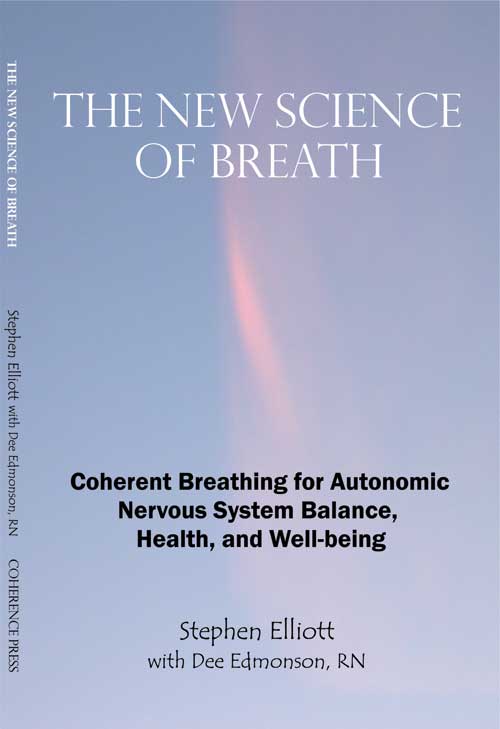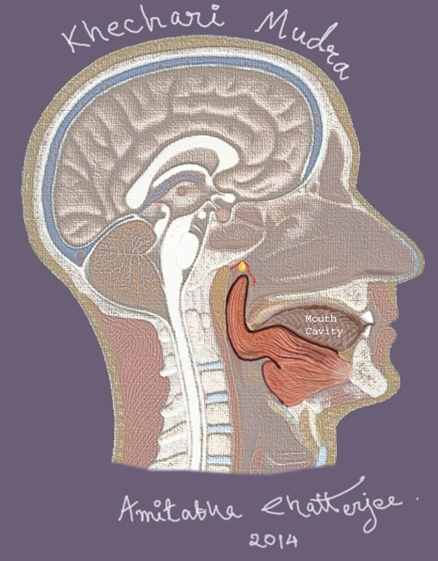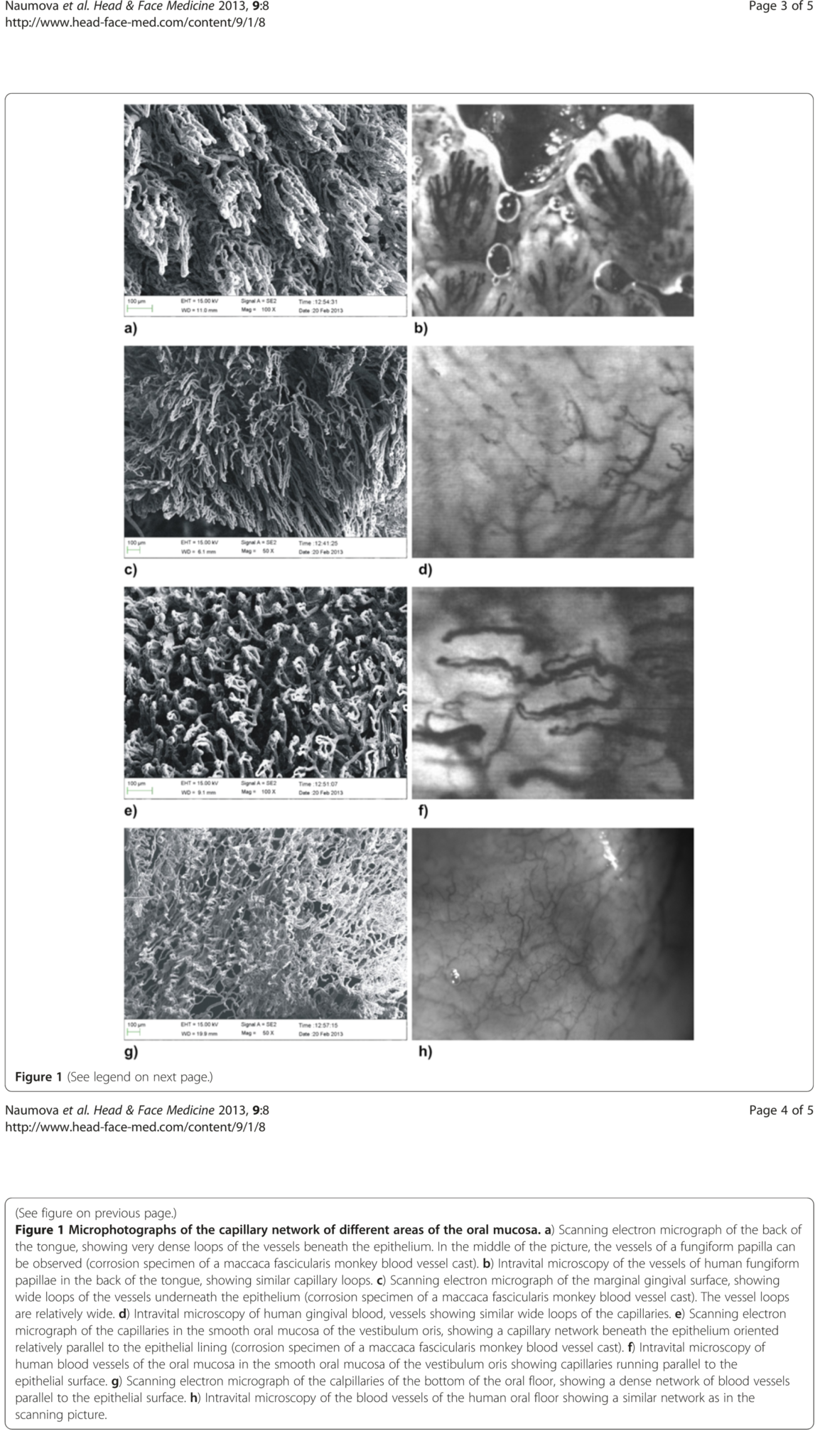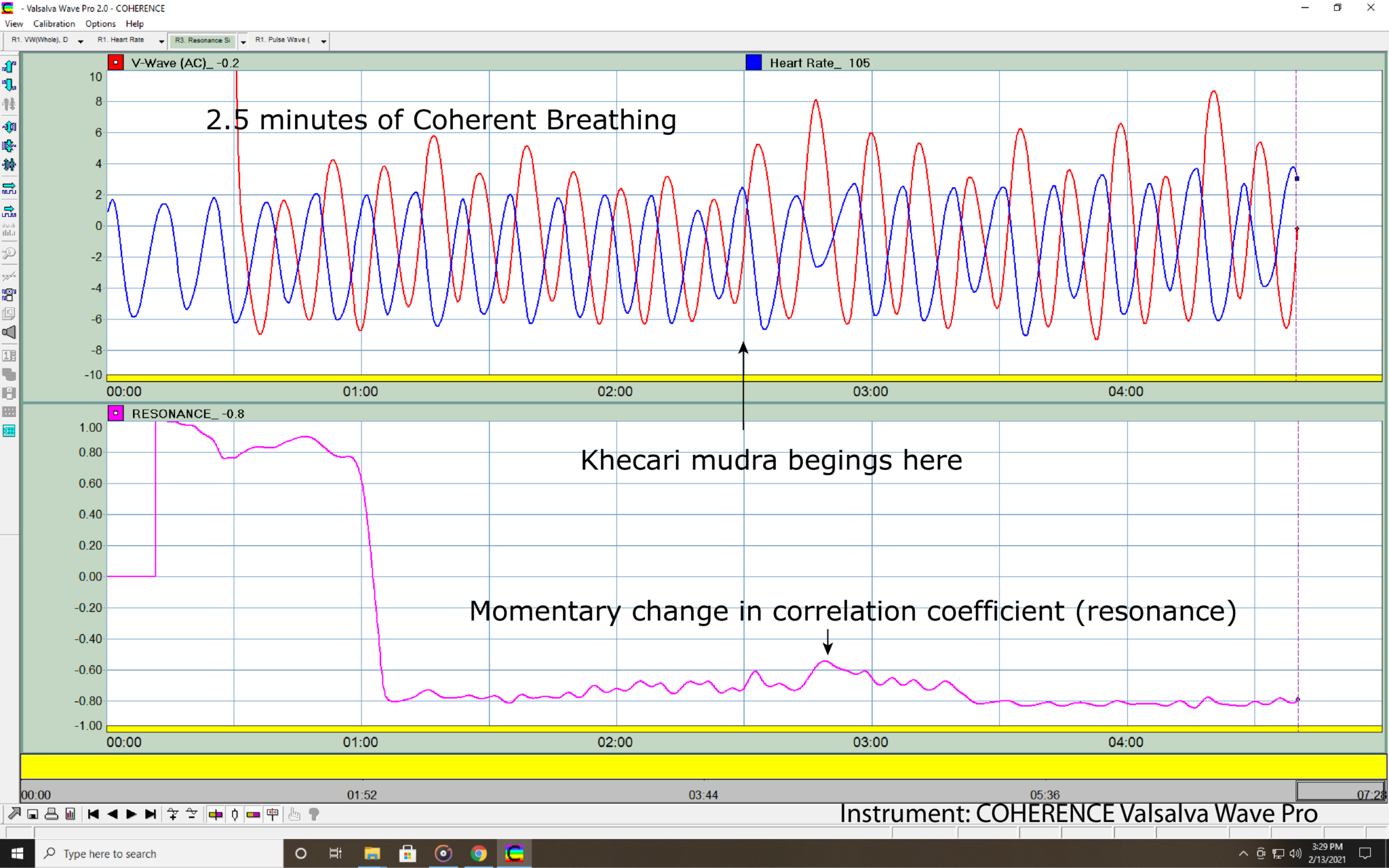Use the Search magnifying glass above to search the site. Use CNTL+F to find text on pages; Apple, use Command+F.
Khechari Mudra In The Time Of COVID-19

COHERENCE, Vol 1, Issue 1 February 14, 2021, by Stephen Elliott, Life Scientist, COHERENCE (updated January 31, 2022)
Keywords: Breathing, circulation, Coherent Breathing®, immune system, hatha yoga pradapika, khechari mudra, nasal turbinates, nitric oxide, respiration, traditional Chinese medicine, Valsalva Wave®
Breathing through the nose vs. the mouth has been a topic of significant interest and discussion in the last few years, this subject being treated thoroughly by Patrick McKeown and James Nestor in their books, The Oxygen Advantage, and Breath, respectively. Nasal breathing as a general health principle is important for a number of reasons including filtration of incoming air, this filtration serving to eliminate particles and foreign debris, warming and humidifying, and importantly, exposing incoming air to the immune system, the respiratory epithelium covering of the turbinates offering a first line of defense against airborne pathogens entering the nose.
The nasal turbinates are comprised of folds of tissue that have a complex surface structure, this complexity yielding the surprising surface area, where if the tissue were to be flattened, is estimated at a surprising 120 square centimeters or ~18 square inches. (1)
The eye is not capable of seeing the turbinates, much less their microscopic surface structure, so it’s something that we find difficult to wrap our minds around.
[As a point of interest, activated carbon is possibly the most mind blowing example of microscopic surface where 1 gram is estimated to have an area of several thousand square meters. This is the reason why activated charcoal is so effective as a filtering medium, be it the filtration of chemical contaminants out of air, e.g. air filters for the home, powered air purifying respirators used in industry, etc., and the purification of water for drinking, aquariums, manufacture, etc. When either foreign object debris or chemicals make their way into the complex microscopic structure of activated carbon they get trapped.]
The nasal turbinates do not consist of convoluted microscopic tunnels as does activated carbon but they do present the nasal epithelium, a complex surface that is covered with mucus over which air must flow, thereby trapping matter, both large and microscopic, where incoming pathogens get exposed to antibodies which serve to neutralize threats. The role of the epithelium throughout the body is to “protect” it from threats posed by the “external environment”.
The spatial environment of the nose is rich in the gas nitric oxide, NO originally thought to be generated and concentrated in the paranasal sinuses, making its way into the nose in less concentrated form therefrom. There is still scientific back and forth on where NO in the upper respiratory tract originates, a reason being that it is a difficult thing to measure.
Nitric oxide is both a signaling molecule and an anti-pathogen, the discovery of NO’s signaling role in the cardiovascular system winning the 1998 Nobel Prize for physiology, jointly awarded to Robert Furchgott, Louis Ignarro, and Ferid Murad. (Watch this brief 2012 interview with Louis Ignarro.) There, it functions as the mechanism by which the endothelium of the arterial tree is signaled to expand and contract, maintaining viable/optimal circulatory capacity from the aorta down to the smallest arteriole in real time, throughout the entirety of the body. NO is also known to play an important role in defending against bacteria, fungi, viruses, and parasites in the respiratory tract (2), accomplishing this via nitrosative and oxidative damage to incoming pathogens. Another immune system role of NO is that it modulates T cell-mediated immune response. (3) A toxic gas and a free radical, it is one of few “environmental toxins” that play an almost universal role in the physiological processes of mammalian life.
Once synthesized, nitric oxide has a half-life up to 6 seconds (4), so it must be synthesized locally by cells throughout the body including the brain where it acts as a neurotransmitter. It is synthesized by a group of enzymes referred to as “nitric oxide synthases”, which convert the amino acid arginine into citrulline, a byproduct being nitric oxide. A major source of arginine is the kidneys which take citrulline produced by the small intestine arriving in plasma and convert it into arginine which is then released into the renal vein and inferior vena cava where it finds its way back into the circulation at large. (5)
Healthline’s “5 Ways to Increase Nitric Oxide Naturally” (6) explains that diet plays a critical role in nitric oxide production because NO is derived from nitrate, the only source of nitrate being dietary intake. (As author, I recommend reading this Healthline article in its entirety.) To this end, the article suggests eating vegetables high in nitrate principally including green leafy ones, citing celery, chervil, lettuce, and of course beetroot, as beets are one of the vegetables that is highest in nitrate with >250mg of nitrate per 100g of fresh weight.
The article also suggests increasing intake of antioxidants including vitamin C, vitamin E, polyphenols and glutathione, this to limit the number of free radicals that can serve to neutralize nitric oxide, itself a free radical and a reason it is susceptible to neutralization by other free radicals.
A third recommendation is to use nitric oxide boosting supplements including L-Arginine and L-Citrulline, both essential amino acids that are ultimately involved in the production of nitric oxide. Both have been popular pre-work-out supplements for decades because they facilitate increased circulation and with it the necessary hydration, nutrition, and metabolic waste removal, from energy producing cells and working muscles. They accomplish this via boosting nitric oxide availability and consequent vasodilation.
A beautiful multi-purpose function of nitric oxide generation in the upper airways is that when inhaled, NO advantages the lungs via vaso and bronchodilation, helping keep the lungs free of obstruction, but also providing potential advantage to other downstream “remote physiological processes”, within its 6 second lifespan.
In 2020 researchers in China published a paper that asks the question, “Could nasal nitric oxide help mitigate the severity of COVID-19?” (7) (Does nitric oxide in the breath inhaled through the nose present immune advantage?), where evidence they gathered during the SARS epidemic of 2002-2003 strongly suggests that it does, principally through NO’s action as a vaso and bronchodilator. In the medical experimentation reported by this article they aided the air being supplied to patients suffering from acute respiratory stress with an external source of NO, with the finding that it produced beneficial effects including decreased pulmonary hypertension, improved arterial oxygenization, and reduced infiltration of disease.
Research 21 years earlier by, P.G. Djupesland and colleagues, “Nitric oxide in the nose and paranasal sinuses – respiratory tract physiology in a new perspective” (9), posited that NO originating in the zone of the upper respiratory tract, a) is a first line of defense against microorganisms, and b) may improve pulmonary function, and circulatory system effectiveness throughout the body. So this thesis is not new.
As it relates to Coherent Breathing, my principal argument for nose breathing is that via the turbinates, the autonomic nervous system optimizes air flows and pressures into and out of the lungs, and on the other side of the lung construct, optimizing blood flows and pressures, where the nominal volume of 5L of blood makes its way through the lungs ~1 time per minute under extremely low pressure.
The ANS accomplishes this in real-time by modulating the size of the turbinates, via modulating their blood volume via nitric oxide emission, causing them to shrink and swell, and thereby controlling the volume of incoming and outgoing air, as well as the work that the diaphragm must perform in order to “breathe”, where the homeostatic imperative is for the blood flow in the venous tree to equal the blood flow in the arterial tree, breath-to-breath. (Otherwise arterial pressure rises.) I have always considered the possibility that the nasal epithelium, and in particular the nasal turbinates could be emitting NO, this being because NO is the primary mechanism by which they shrink and swell as a consequence of blood vessels contracting and expanding. But this remains conjecture…
Khechari mudra is a Shaivist meditation technique, where I cite Shaivism as it is fundamentally oriented around the arousal of kundalini, where khechari mudra is a means of bridging or connecting the sushumna, the vertical centerline of the body, to the base of the brain and the chakras that exist in and above the head.
It is hard for us to know for sure when and how khechari mudra came to be recognized and for what purpose(s). In addition to its role of bridging the sushumna between neck and head, it is also a “lock” on speech, as one cannot speak when the tongue is positioned in Khechari mudra. When one goes without speaking, words stop forming, and the mind can be quiet. Here khechari mudra aids in silencing the Saptamatrikas, and in doing so, bringing an end to objectification and dualism.
Khechari mudra’s role in “protection” against disease is a subject that requires additional research.
Figure 1: The Valsalva Wave
I’ve thought the Valsalva Wave phenomenon generated by the “thoracic pump” to be primarily mechanical in origin, i.e. changing pressure in the thoracic cavity as a function of diaphragm position and motion, air flow modulated by the nasal turbinates both during inhalation and exhalation, but I have not considered the role that NO might be playing relative to its generation. An interesting question… There is also the matter of nose vs. mouth breathing. If nitric oxide is produced by the paranasal sinuses and finds its way into the nasal passages, is NO advantage only offered by nasal breathing? Where is the first line of defense if one is breathing through their mouth, as we must do when the demand for energy generation is great?
~
Khechari (catch-ari) mudra is an age old yogic method, at least as old as the Hatha Yoga Pradipika, circa 1350 C.E. It means “tongue lock” or “seal”. (9)
The New Science Of Breath (Amazon) includes a few paragraphs about khechari mudra. “Mudra also plays a role in moderating autonomic nervous system balance. Again from Light on Yoga, “There is no asana like Siddha, no kumbhaka like Kevala, no mudra like Khechari, and no laya like Nada.” Khechari mudra involves rolling the tongue backward and upward, stretching it upward so that the tip rests lightly against the roof of the nasal pharynx. In this position, the tongue functions as a pranic bridge connecting psychic centers in the head with those in the throat and torso. During meditation, khechari mudra results in a substantially deeper meditative experience. It is hypothesized that it accomplishes this by eliciting parasympathetic emphasis…
THE NEW SCIENCE OF BREATH (2005) by Stephen Elliott with Dee Edmonson, RN, BCIAC-EEG
As with mantra, for khechari mudra to be powerful it must be cultivated via continued practice. The yoga aspirant is encouraged to hold khechari mudra, not only while meditating but throughout the day except when engaged in necessary speech. In this way, khechari mudra functions to slow the breathing frequency and increase breathing depth, leading toward autonomic balance and cardiopulmonary resonance.”(10)
When the tongue is positioned in khechari mudra it partially blocks the nasal passages, slowing the flow of air into and out of the lungs, incoming air must flow around and over the sides and dorsal surface of the tongue to reach the laryngopharynx, and the reverse upon exhalation. This requires diaphragm control to be slightly more deliberate. When the tongue is in khechari mudra, it is impossible to breathe through the mouth, as the tongue completely “seals” the mouth from the throat. If one holds one’s nose and tries to inhale through the mouth, not the slightest bit of air makes it around the tongue and into the throat.
Figure 3: Hatha Yoga Pradapika, Verse 40 (12)
Hatha Yoga Pradipika (1350 C.E.), Chapter 3, Verse 40 says: One who knows khechari mudra is unafflicted by disease…
Why would this be so?
Is it possible that khechari mudra was found to play an important role in keeping one free from disease in past times of epidemic?
As author, I posit that this is a probability, not that khechari mudra does not offer other esoteric advantages. My father taught this to me when I was very young, maybe 10 years old. As children we were all challenged to learn to coordinate the tongue in all matter of ways, turning it over left and right, rolling it to form a tube, touching the back of the throat – Sunday afternoon fun in the Elliott living room. My dad always admonished, “Just don’t swallow your tongue.” I remember asking and arguing about whether or not it is even possible to swallow one’s tongue. My dad said, “Oh yeah, in which case you would choke to death.” I don’t know if he was pulling our legs or not. Anyway, I’ve been able to do this since childhood and have used it throughout life as need be, including during meditation. But I have not considered whether or not it might protect one from disease until COVID-19, in which case, I’ve used it very deliberately for almost a year now, especially when I am around other people.
So, I posit that khechari mudra may in fact perform an important protective function, not dissimilar to that of the nose with its nasal turbinates, but in this case “in addition to” the nose. It is known that the tongue also plays an important role in immunity where air we breathe through the mouth passes over the tongue. Here again, due to the complexity of its surface, the tongue possesses a surprising surface area. There is a dearth of inquiry into the physiology of the tongue, but there is one preeminent research article that looks into it, titled The Oral Mucosal Surface And Blood Vessels, published in March of 2013, where one of the things researchers did was measure the surface area of the tongue. (13).
In order to do this they made silicon casts of the tongues of 5 cadavers, silicon being used because it is capable of extremely fine definition, hence its pervasive use in the manufacture of silicon chips, microprocessors, etc. Using the casts, they then went on to measure the surface areas of each aspect of the tongue using a profilometer, a device that can accurately “profile” and measure microscopic phenomena, calculating height, width, depth, area, and volume of every microscopic feature, both individually and together. (See Figure 4.) Their finding is that the tongue has an average total surface area of 190 square centimeters or ~29.5 square inches, an area even larger than that of the nasal turbinates.
Because the tongue is integrally involved in the process of mastication, food we consume is exposed to much of this area. Liquids we ingest are exposed to the entire tongue, including the underside, surface area totaling ~30 square inches. Air we breathe is exposed primarily to dorsal and lateral aspects, totaling 12 square inches.
These numbers are difficult to understand without the aid of microscopy. Figure 4 provides a glimpse of what the tongue of a monkey looks like under an electron microscope – a highly complex web of microscopic blood vessels. (13) The same is thought to be true of human tongues, though the search for electron microscope images of the human tongue continues…
Figure 4: Scanning Electron Microscope Of Surfaces Of A Monkey Tongue (Courtesy Head & Face Medicine)
Inquiry into the role of the tongue in immunity was posited in 2020, by Jane Wu, a question that naturally comes forth from Traditional Chinese Medicine, where the tongue has been a major means of diagnosis going back thousands of years. The title of Wu’s article is “Tongue as a first-line immune organ?” (14), where she goes on to say that for an organ that is situated at the beginning of the gastrointestinal tract, it is “remarkably understudied”. Her article posits, based on the scientific literature that does exist, that of course the tongue is a first line of defense relative to the mouth, the epithelial layer of the mouth and tongue performing a like function to that of other epithelia, protection from the external environment, but that the immune cells of the tongue have never been studied in depth or cataloged.
“Tongue” does not exist in the index of Berne and Levy’s “Physiology“. Guyton and Hall’s “Medical Physiology” has approximately 1 full page discussing the taste bud and its function.
The tongue is also known to be a source of nitric oxide (15), where in the case of the tongue it is bacteria on the dorsal surface that generates nitric oxide, using saliva, a rich pool of nitrate in the mouth, bacteria converting nitrate into the gas nitric oxide, this NO serving very much the same purpose as that of the nose when we breathe through the mouth, it serves as antipathogen in the mouth and airways and brocho/vaso dilator upon reaching the lungs and bloodstream.
The amount of nitric oxide generated by the bacteria of the tongue is significant. When researchers had study participants use chlorohexidine gluconate mouthwash (a broad spectrum germicidal) twice daily, within 1 week rises in systolic blood pressure were observed. (15) This increase is credited to a decrease in NO producing bacteria. Observations relating to this study also note that in order to optimize NO production by the tongue, it is important to manage bacteria on the tongue. This is because NO producing bacteria can be overrun by non-NO producing bacteria. For this reason, regular non-chemical tongue cleaning is a recommendation coming from the research.
~
Returning to khechari mudra…
In the time of COVID-19, where the air we breathe is potentially laden with virus, khechari mudra may be a 2nd layer of immunological protection, the first being provided by nasal breathing and the immunological function of the nose and nasal turbinates.
When we breathe through the nose alone, we are receiving nitric oxide primarily from the nose, but certainly aided to some degree by NO from the tongue. When we breathe through the mouth, roles reverse where most of the NO we receive is coming from the tongue, but to some degree from the nose.
When we assume khechari mudra, the mouth is sealed and the dorsal surface of the tongue is positioned in the airway behind the nasal openings such that when we inhale/exhale through the nose, air must also flow over and around the dorsal and lateral surfaces of the tongue, where we are now inhaling nitric oxide from both nose and tongue combined. Khechari mudra also generates a relatively intense vacuum in the location where the tongue is touching the nasal pharynx. Does this vacuum pull nitric oxide from the paranasal sinuses more effectively than a normal inhalation when not engaged in khechari mudra? Do these aspects of khechari mudra in combination, ultimately result in substantially safer intake of air and more nitric oxide intake into the airways and lungs where it performs its antipathogenic function as well as its broncho and vasodilation functions?
Figure 5: Valsalva Wave Pro depicting Coherent Breathing with and without khechari mudra
Figure 5 presents a 27 year old male trained in Coherent Breathing and khechari mudra demonstrating both Valsalva Wave and HRV amplitudes and phase correlation while breathing Coherently followed by the assumption of khechari mudra. The sensor is attached to the earlobe. We can see an immediate increase in Valsalva Wave amplitude which grows during both inhalation and exhalation phases. HRV remains roughly stable. Is this growth in Valsalva Wave amplitude due to increased pressures presented by the assumption of khechari mudra both during inhalation and exhalation or is it a function of increased nitric oxide as a function of the presentation of the dorsal and lateral aspects of the tongue to incoming and outgoing air – or both?
If when employing khechari mudra, nitric oxide is that of nose + tongue, and the pressures required to inhale and exhale are increased, then we can expect more nitric oxide to make it into the the alveoli and cross over into the pulmonary capillaries during inhalation. Increased pressure during exhalation would expedite the wave of blood leaving the lungs, sending it to the left heart and into the arterial tree.
Continuing with this musing, because of the 6 second lifespan of NO, the viability of the nitric oxide during an inhalation is timed, where the concentration of NO in the alveoli is probably highest during mid-inhalation when air flow peaks, this NO passing into the blood under quiescent pulmonary flow, but it is likely the last moments of inhalation, just before exhalation begins where NO with the longest remaining life span enters the alveoli and the blood, exhalation then sending it as part of the wave of blood headed toward the left heart and arterial tree. This would be very interesting to know…
The April 2020 article, “The first holistic immunological model of COVID-19: Implications for prevention, diagnosis, and public health measures”, asserts that whether or not the virus reaches the lungs first is a crucial determinant in disease outcome. Secondly, if one already has COVID-19 in their upper respiratory tract, extreme physical exertion resulting in forceful breathing or hyperventilation can draw viral load into the lungs and lung alveoli, something that should be avoided. The article hypothesizes “viral auto-inhalation”, where when one has the COVID-19 infection in the upper airways, forceful exhalation followed by forceful inhalation has the potential to draw virus in the upper airways deep into the lung alveoli, resulting in more serious illness. (16)
This implies that breathing slowly, deeply, and gently through the nose is even more important now. In my experience, khechari mudra aids this process. The possibility exists that it may be multi-functional in this regard.
~
Khechari mudra is a Shaivist meditation technique, where I cite Shaivism as it is fundamentally oriented around the arousal of kundalini, where khechari mudra is a means of bridging or connecting the sushumna, the vertical centerline of the body, to the base of the brain and the chakras that exist in and above the head.
It is hard for us to know for sure when and how khechari mudra came to be recognized and for what purpose(s). In addition to its role of bridging the sushumna between neck and head, it is also a “lock” on speech, as one cannot speak when the tongue is positioned in Khechari mudra. When one goes without speaking, words stop forming, and the mind can be quiet. Here khechari mudra aids in silencing the Saptamatrikas, and in doing so, bringing an end to objectification and dualism.
Khechari mudra’s role in “protection” against disease is a subject that requires additional research.
References:
1) The Upper Airway Physiology and the Atmospheric Environment, D.F. Proctor and I Andersen, Eds., Elseivier/North Holland, Amsterdam, 1982, pp 23-43.
2) The potential of nitric oxide releasing therapies as antimicrobial agents, Virulence, May, 2012, 3 (3), 271-279.
3) Nitric Oxide Signaling in T Cell-Mediated Immunity – PubMed (nih.gov)
4) Inhaled nitric oxide applications in paediatric practice, IMAGES in PAEDIATRIC CARDIOLOGY, 2002, Jan-Mar, 4:(1) 4-29.
5) Arginine Metabolism: Enzymology, Nutrition, and Clinical Significance, Renal Arginine Metabolism,
6) Arginine Metabolism: Enzymology, Nutrition, and Clinical Significance, Renal Arginine Metabolism, Brosnan, Margaret E., Brosnan, John T., Department of Biochemistry, Memorial University of Newfoundland.
7) 5 Ways to Increase Nitric Oxide Naturally, Va DeWalle, G., Healthline, April, 2018.
8) Could nasal nitric oxide help to mitigate the severity of COVID-19?, Microbes and Infection, 22, (2020), 168-171.
10) Hatha Yoga Pradipika, Swami Muktibodhananda, Yoga Publications Trust, Munger, Bihar, India, Chapter 3, pg. 310.
11) The New Science Of Breath, Elliott, S., Edmonson, D. Coherence Press, 2005.
12) Khechari Mudra by Amtritabha Chatterjee
13) Hatha Yoga Pradipika, Swami Muktibodhananda, Yoga Publications Trust, Munger, Bihar, India, Chapter 3, Verse 40, pg. 315.
15) Tongue as a first-line immune organ? Wu, Jane., Protein Cell, Department of Neurology, Center for Genetic Medicine, Lurie Cancer Center, Northwestern University Feinberg School of Medicine, October, 2020.
16) Nitric Oxide Concentration and Other Salivary Changes after Insertion of New Complete Dentures in Edentulous Subjects, International Journal Of Dentistry, Volume 2016, Article ID 8351427, Breseghelo, M., Guillo, L., Nogueira, T., Leles, C.
17) The first, holistic immunological model of COVID-19: Implications for prevention, diagnosis, and public health measures, The first, holistic immunological model of COVID‐19: Implications for prevention, diagnosis, and public health measures – Matricardi – 2020 – Pediatric Allergy and Immunology – Wiley Online Library
Copyright COHERENCE LLC 2021







